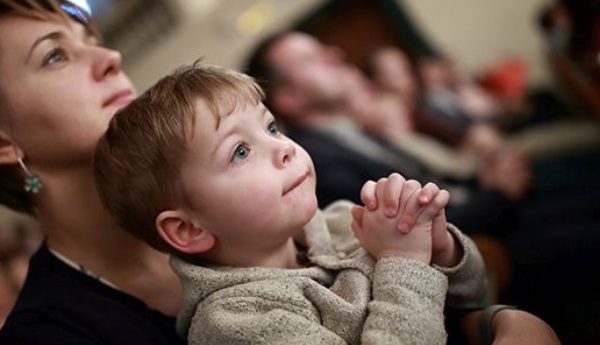Whenever we talk about including all ages in corporate worship, one of the concerns that gets raised is whether or not developmental needs of all ages are being met in that context. Often this is specifically used to reference the inclusion of children in the larger worship context.
But sometimes this view is based on a narrowly defined area of developmental research and theories and a wider look at developmental psychology can give us a broader view of what it means for something to be “developmentally appropriate.”
Like most research, developmental theories are just that – theories. Lots of research continues to be done in early childhood development. Most people only think about cognitive development as the ability to understand certain things like words in a sermon or abstract concepts like worship. However, if we are looking at basics of development, it’s helpful to think bigger than that.
Development not just about what children can understand in terms of words and concepts; it’s about what they can learn socially, emotionally and in our case, spiritually.
Here are a few research-based reasons that support the inclusion of all ages, including younger children, in times of corporate worship and intergenerational learning.
- Vygotsky’s Zone of Proximal Development– This developmental theory explains that young children need to be in close proximity to older people who have “mastered” the tasks that they are learning. For instance, a four-year old is going to learn how to stack blocks better when playing with a 6 year old who has mastered the trick.

When we are talking about church, these young children learn what church is, how to act, what is expected by being in close proximity to adults who are practicing especially their parents who hold the most influence on their children’s spiritual lives. Here’s a great article about the power of the Zone of Proximal Development.
- Observational learning is another powerful developmental tool for young children. Watching others model what they should do is an important part of social development and one that has been lacking to in the larger church. This is often why when youth “graduate” from youth group, they don’t know how to interact socially with the larger church body and often end up leaving the church and saying they don’t feel like they belong.
Creating opportunities for observational learning can be tricky if a church is structured in a way characterized by all ages being separated from one another. The key is to create spaces where generational interaction can take place. For some practical tips and ideas for creating spaces where generations can connect together in worship and discipleship, check out this article.
- Fowler’s theory of Faith Development – Probably the best known developmental work in the area of faith comes from James Fowler and is based heavily on the work of Piaget, Erikson and Kohlberg (Check out the book The Church of All Ages by Howard Vanderwell, Chapter 3 for much more on this).
In Fowler’s first stage (preschool aged children up to age 6) called the Intuitive-Projective faith stage, children basically reflect the spirituality of their parents. Children will build their first ideas about their faith from the impressions of what they see and hear in church.
The second stage (age 6-11) is called the Mythic-Literal stage where kids begin to learn the stories of the faith and articulate their own beliefs. That belief is largely mitigated by information they get from others and parents begin to share their influence with the rest of the church family. Framing sermons with a biblical story is a perfect way to invite this age into the sermon.
Other noted developmental ideas come from the work of Jean Piaget whose first two stages of development put a high premium on the importance of language combined with sensorimotor exploration. This is why sensory bags or activity bags during services can be such a powerful tool for helping children engage during worship time.
Activity bags get a bad rap, mostly because people don’t understand the developmental science behind them. It’s important to understand that these activities aren’t intended to distract the kids but rather to help the kids use all of their developing senses; studies show if their hands and eyes are busy, their ears will be listening. Quiet activities like lacing cards, stickers scenes, foam craft kits, beads and pipe cleaners, small puzzles and coloring are all great ways to engage your kinesthetic and visual learners.
The truth is if we look at the broad spectrum of developmental theories including these and others not mentioned here like Erikson’s stages of psychosocial development or Kohlberg’s stages of moral development, we can find space in all of them for including all ages in contexts of intergenerational worship and ministry. Because ultimately, as social creatures, humans learn best from one another regardless of age. That means developmental appropriateness is something we can incorporate into any setting where we connect with other, especially others at different stages of development than we are.
Does that mean we shouldn’t have age-sensitive spaces?
No, not at all. There are lots of other developmental reasons to have spaces that meet our unique developmental needs. For instance, the ability to think abstractly is a characteristic of higher levels of development; until then, concrete thought is our primary means of processing. So we should have places where concrete access to learning is granted.
But to say that excluding children from corporate worship is necessary due to the fact that they are not developmentally able to be there is a fallacy and it limits the definition of what it means for something to be “developmentally appropriate” to a very narrow scope.
The truth is that worship services where all generations interact and connect can be developmentally appropriate if we are willing to broaden our understanding and find ways to build on the developmental stages we all find ourselves in. That would also mean we would craft environments that aren’t targeted to a couple of generations but we would take the time to ensure each member in attendance would be able to participate in developmentally appropriate ways.
Instead of using developmental research to keep us apart, we can use it to create ways of connecting, learning and growing together. And in that way, we can even more fully explore what it means to be the body of Christ.
For more information about
- Kids in Worship
- Determining which Type of Family Ministry model works best for your church
- Discipleship in Intergenerational community
- Encouraging the continued conversation through Practical Discipleship at Home
- Seminars, Workshops, Coaching
Check out to ReFocus Ministry or “like” our Facebook page. Join our conversation at theReFocus Family and Intergen Ministry group on Facebook.
About this Blog

Refocus Ministry was started by Christina Embree, wife to Pastor Luke, mom to three wonderful kids, and church planter at Plowshares BIC. With years of experience in family ministry and children’s ministry, she is passionate about seeing churches partnering with families to encourage faith formation at home and equipping parents to disciple their kids in the faith. She recently graduated with a Masters of Arts in Ministry focusing on Family, Youth and Children’s Ministry at Wesley Seminary, she also blogs at www.refocusministry.org and is a contributing blogger at D6 Family, ChurchLeaders.com, and Seedbed
*The advertisements on this page are chosen by WordPress, not by ReFocus Ministry and do not necessarily reflect the opinions and values of the author.


7 Comments